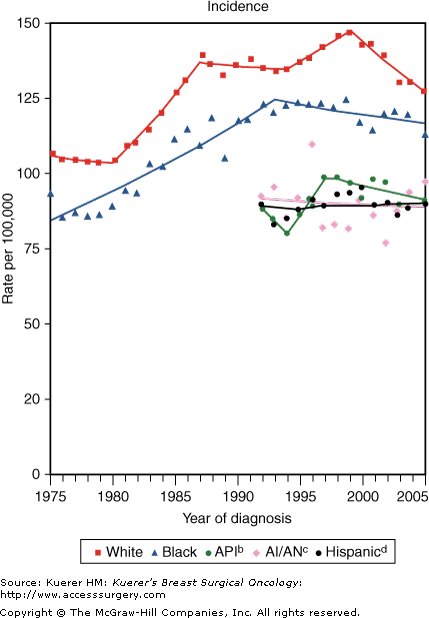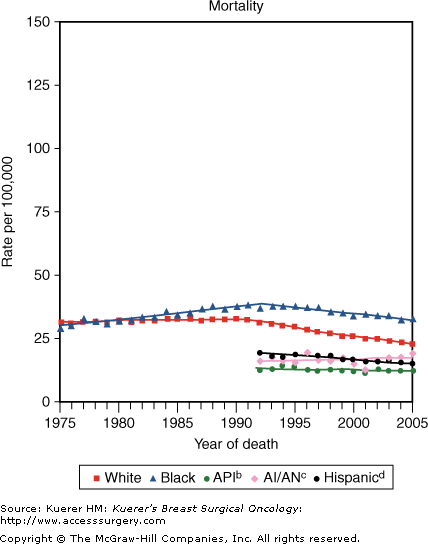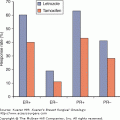Breast cancer is the most common female malignancy in the United States and worldwide. The World Health Organization estimates that more than 1 million cases of breast cancer occur annually. In 2000, the last year in which worldwide data was available, more than 400,000 women died of breast cancer.1 Over the last several decades, a growing literature has described disparities in the incidence, treatment, and survival from breast cancer between populations delineated by socioeconomic, racial/ethnic, and cultural characteristics. Despite a growing recognition that disparities exist, the underlying causes of these disparities are not well understood. Factors affecting the incidence of and survival from breast cancer are no doubt multifactorial, including biological and genetic factors, environmental factors, reproductive factors, and dietary factors. Despite significant advances in the detection and treatment of breast cancer, these disparities have persisted. This review will focus primarily on disparities in breast cancer incidence, treatment, and outcome between African American and white women, as this represents the best established literature.
Evidence of the racial and socioeconomic differences in the incidence and mortality from breast cancer is compelling. The best population-based evidence of these disparities comes from the Surveillance, Epidemiology, and End Results (SEER) Program. This program was started in the United States in 1973 to describe the incidence and outcomes from cancers. Initially, 9 sites were involved, including 5 states (Connecticut, Hawaii, Iowa, New Mexico, and Utah) and 4 major cities (Detroit, Atlanta, San Francisco, and Seattle); however, the program has now grown to include 16 sites. In 2001, sites were added in Louisiana, Kentucky, New Jersey, and California to further improve the representation of minorities. This database now represents the largest collection of cancer registries in the United States. The SEER program is estimated to include 26% of the US population. SEER coverage includes 23% of African Americans, 40% of Hispanics, 42% of American Indians and Alaska Natives, 53% of Asians, and 70% of Hawaiian/Pacific Islanders.2 Although race is documented in the SEER database, the racial and ethnic heterogeneity of the US population presents a challenge to correctly accounting for these complex relationships. Despite this limitation, the SEER database has provided researchers and clinicians with robust population-based estimates of the cancer incidence and survival.
The incidence of breast cancer has significant racial variation. Using the most recent SEER data, African American women have a lower age-adjusted incidence of breast cancer as compared with white women (117.5 vs 130.6 per 100,000 respectively) (Fig 102-1). Similarly, Asian/Pacific Islander, Hispanic, and American Indian/Alaskan Native women all have lower incidence of breast cancer as compared with white women (89.6, 90.1, and 75.0 per 100,000 women, respectively).2
Although African American women have a lower cumulative incidence of breast cancer as compared with white women, young African American women have higher incidence of breast cancer as compared with similarly aged white women. In women younger than 45 years, African American women have a higher incidence of breast cancer as compared with white women, and this incidence equalizes in the fifth decade. After age 50, white women have a significantly higher incidence of breast cancer. As a consequence, African American women have a lower median age at diagnosis as compared with white women (57 vs 62 years, respectively).3
Overall, nearly three-quarters of all women diagnosed with breast cancer have infiltrating ductal carcinoma. The histologic type, grade, and stage of breast cancer varies significantly with race. In particular, African American women had a significantly higher risk of presenting with inflammatory breast cancer as compared with white women (relative risk [RR] = 1.4; 95% confidence interval [CI], 1.3-1.5).4 Similarly, several studies have shown that African American women have a higher risk of medullary breast cancer.5,6 Some have suggested that the higher incidence of medullary tumors may in fact be a reflection of a higher frequency of misdiagnosed high-grade infiltrating ductal carcinoma lesions, which can often be confused with medullary cancer.3 Regardless, it appears that African American women are more likely to present with more aggressive tumor types.
As well as presenting with more aggressive histology, African American women are also more likely to present with locally advanced disease (RR = 1.8; 95% CI, 1.7-2.0).4 In this analysis, African American women were more likely to present at a younger age and generally had worse survival.
African American women have consistently been shown to present with more advanced disease and hormone receptor–negative disease. The results of several of these studies are shown in Table 102-1. In 2002, Anderson and colleagues reported that African American women were more likely to present with estrogen receptor–negative disease; these findings have been confirmed by multiple studies.7-10 Several studies have also noted that African American women are more likely to present with tumors expressing multiple abnormal proteins, including p53, p16, and cyclins D1 and E.11,12 Although African American women are more likely to present with estrogen receptor–negative tumors, it appears that there is no racial difference in the rate of HER-2/neu overexpression.13,14
| Study | Dataset | Features | White Americans | African Americans |
|---|---|---|---|---|
| Chlebowski et al, 2005 | WHI Postmenopausal | N | 3455 | 242 |
| Mean tumor size (cm) | 1.56 | 1.6 | ||
| High-grade tumors (%) | 25 | 43 | ||
| ER-negative (%) | 13 | 29 | ||
| PR-negative (%) | 24 | 41 | ||
| Mortality hazard (95% CI) | 1.0 (ref) | 1.79 (1.05-3.05) | ||
| Li et al, 2003 | SEER | N | 97,999 | 10,560 |
| Stage (%) | ||||
| I | 50.4 | 35.4 | ||
| III/IV | 11.3 | 18.9 | ||
| High-grade tumors (%) | 32.1 | 43.2 | ||
| Tumor 5 cm (%) | 8 | 15 | ||
| Node negative (%) | 53.9 | 42.6 | ||
| ER-negative (%) | 22 | 39.2 | ||
| PR-negative (%) | 31.7 | 46.6 | ||
| Mortality hazard (95% CI) | 1.0 (ref) | 1.5 (1.4-1.6) | ||
| Li et al 18, 2002 | SEER | N | 75978 | 6915 |
| Age ≥ 50 years | Stage (%) | |||
| I | 53.2 | 39.1 | ||
| III/IV | 11.1 | 19.1 | ||
| High-grade tumors (%) | 29 | 37.6 | ||
| Tumor 5 cm (%) | 7.4 | 14.1 | ||
| Node negative (%) | 54.3 | 43.2 | ||
| ER-negative (%) | 15.2 | 24.1 | ||
| PR-negative (%) | 23.8 | 30.4 | ||
| Newman et al, 2002 | Detroit SEER | N | 1378 | 507 |
| Age ≥ 40 years | Localized Stage (%) | 52.1 | 42.4 | |
| Median tumor size (cm) | 2.6 | 3.4 | ||
| Node-negative (%) | 45.7 | 33.3 | ||
| ER-negative (%) | 44.4 | 61.9 | ||
| PR-negative (%) | 48.8 | 59.7 | ||
| Mean survival (months) | 50 | 45 | ||
| Shavers et al, 2003 | SEER | N | 2638 | 724 |
| Age ≥ 35 years | Stage (%) | |||
| I | 26.7 | 16.4 | ||
| III/IV | 12.3 | 16.7 | ||
| High-grade tumors (%) | 43.3 | 54.8 | ||
| Median tumor size (cm) | 2.5 | 2.8 | ||
| Node negative (%) | 44.6 | 36.5 | ||
| ER-negative (%) | 33.1 | 34.4 | ||
| PR-negative (%) | 35.4 | 35.6 | ||
| 5-year disease-specific survival | 76.5 | 66.6 | ||
| Mortality hazard (95% CI) | 1.0 (ref) | 1.3 (1.0-1.6) | ||
| Elledge et al, 1994 | San Antonio database | N | 4885 | 1016 |
| Age ≥ 50 Years | 76.1 | 62.6 | ||
| P53-pos (%) | 50.9 | 54.9 | ||
| Tumor 5 cm (%) | 10.9 | 27.7 | ||
| Node-negative (%) | 57.9 | 48.8 | ||
| Tumor-5 cm (%) | 10.9 | 27.7 | ||
| Node-negative (%) | 57.9 | 48.8 | ||
| ER-negative (%) | 22.1 | 37.9 | ||
| PR-negative (%) | 44 | 59.2 | ||
| HER-2/neu-positive (%) | 16.1 | 13.8 | ||
| 5-year overall survival (%) | 75 | 65 | ||
| Median survival (months) | 166 | 117 |
In summary, African American women are more likely to present with more advanced breast cancer, at a younger age, and they are more likely to present with estrogen receptor–negative tumors. These characteristics may in part explain differences in breast cancer outcomes, but as will be detailed throughout the chapter, significant evidence exists that even after controlling for the more advanced disease burden, African Americans continue to fair worse than their white counterparts.
Despite a lower cumulative incidence of breast cancer, African American women have a paradoxically higher mortality from breast cancer.2 African American women diagnosed with breast cancer between 1996 and 2004 had a significantly lower 5-year survival as compared with white women (77.8 vs 90.5, respectively).2Figure 102-2 shows the trend in breast cancer mortality stratified by race. The mortality rates from breast cancer have decreased for white women and remained relatively stable among all other racial/ethnic groups. As discussed earlier, African American women are more likely to present with more advanced disease as compared with white women. Even when accounting for more advanced presentations, African American women continue to have a lower survival from breast cancer.2
African American women present with more advanced disease as compared with white American women. These differences in presentation may be partially explained by differential utilization of breast cancer screening. The widespread adoption of mammography after age 40 has been credited as a significant factor in improving breast cancer outcomes.15 This improvement in outcomes has largely been a consequence of identifying breast cancer at an earlier stage. In the period from 1985 to 2005, the incidence of breast cancer diagnosed as in situ nearly tripled.2 Despite these improvements, African American women continue to present with more advanced disease. The existing data regarding the racial differences in the utilization of screening mammography is conflicting. Several studies using survey data from the National Health Interview Survey have reported similar rates of mammography between African American and white American women.16,17 Similarly, in an analysis of survey data from the Behavioral Risk Factor Surveillance System combined from registry data, African American women had a lower rate of screening mammography; however, this difference was not significant.18 Despite similar rates of screening mammography, African American women continued to have a lower odds of presenting with early-stage disease. In contrast, in an analysis of mammography registry data from the National Cancer Institute–funded Breast Cancer Surveillance Consortium, African American women were more likely to receive inadequate screening mammography as compared with white American women (RR = 1.2; 95% CI, 1.2-1.2). This analysis also noted that African American women were more likely to present with large, advanced stage, lymph node–positive tumors regardless of screening interval as compared with white American women.19 In an earlier analysis of Medicare claims data for mammography use linked to the SEER registry, McCarthy et al20 estimated that 30% of the delayed presentation of African American women can be explained by disparate use of screening mammography.
The true utilization of screening mammography among African American women remains unclear. It is evident from both the survey data and registry data, however, that African American women are more likely to present with more advanced disease as compared with white women, even among patients with similar screening patterns.
Although the disparities in breast cancer outcomes between African American and white American women may be partially explained by differences in presentation as noted above, treatment-related differences could potentially explain why African American women with equal stage cancers continue to fair worse than their white counterparts.
Stay updated, free articles. Join our Telegram channel

Full access? Get Clinical Tree








